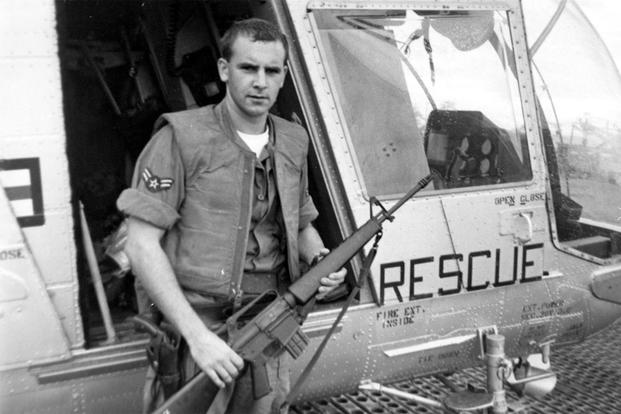The density of the jungle canopy near Cam My made it nearly impossible to lower Airman 1st Class William H. Pitsenbarger in on April 11, 1966. Capt. Harold D. Salem, pilot of the Huskie helicopter, could hardly see as he hovered over a "little bitty" clear spot.
Pitsenbarger, a pararescue medic with Detachment 6, 38th Aerospace Rescue and Recovery Squadron, had been off duty when a call for help came from members of the 1st Infantry Division. He volunteered to go out in the hoist-equipped HH-43 to help organize the rescue effort.
Twenty-one-year-old "Pits" knew how dangerous his position was. Although a first-timer, he was in the final months of his enlistment and had already completed more than 300 rescue missions. He also knew that standard procedure called for him to care for the wounded and then pull out. Yet when Sgt. Gerald Hammond, operating the hoist, beckoned, Pitsenbarger "just gave him a wave-off," recalled Salem. The young medic elected to stay with the men he had come to help.
After an hour and a half, intense fire made it impossible for a chopper to return. Pitsenbarger was on his own. He made stretchers out of saplings and splints from vines and branches. Collecting weapons and ammunition from the dead, he passed them to wounded soldiers, even giving his own pistol to one man who was so badly hurt he could not hold a rifle. When Pitsenbarger had done all he could, he began firing at the enemy.
According to Sgt. Fred Navarro, who was next to him at the time, Pitsenbarger was hit and killed sometime around 7:30 that night. "It was so dark in the jungle, you couldn't see your hand in front of your face," Navarro said.
When Pitsenbarger's body was recovered, it had five enemy bullet wounds. He was posthumously awarded the Air Force Cross, the first airman to be so honored. Yet eyewitnesses like Navarro and Salem knew that a Medal of Honor was a more fitting recognition of Pitsenbarger's heroism.
Because of testimonies like theirs, the Defense Department on Dec. 8, 2000, will bestow the country's highest military honor on Pitsenbarger. His father, now in his 80s, will attend the ceremony at Wright-Patterson Air Force Base, Ohio, to accept the award on his son's behalf. Pitsenbarger is the second enlisted Air Force member to receive the Medal of Honor since the Air Force was designated a separate service in 1947.
Want to Know More About the Military?
Be sure to get the latest news about the U.S. military, as well as critical info about how to join and all the benefits of service. Subscribe to Military.com and receive customized updates delivered straight to your inbox.














